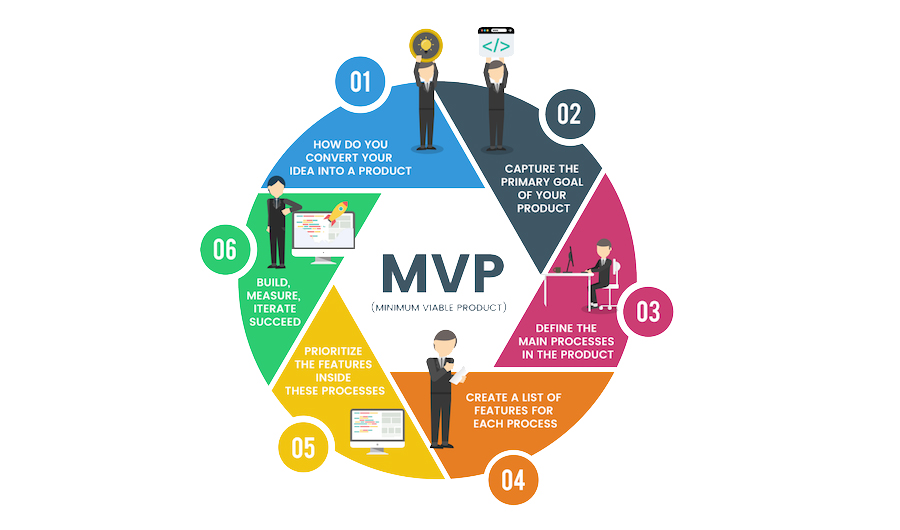Building your first MVP - Part 2
Welcome back. This is the second and final part to Building an MVP. In this post, I will share some of the secrets for building an MVP, pointing you in the right direction to coordinate proper development and to manage your expectations.
Previously, in Part 1, we concluded that an MVP is akin to using a rocket to launch your product off the ground. The MVP validates your business idea, rather than a fully made product, which often takes much longer to build and to get right.
If you haven’t read part 1 of “Building your first MVP” yet, then please do so by clicking here before you proceed.
An MVP can be understood as:
- A digital product, an app, web service or anything that is programmatically made.
- A tool which will let you validate your business idea and test your hypothesis.
- A product stage within the full cycle product development process, according to the lean startup methodology.
The purpose of an MVP is:
- Test Product hypothesis with minimal resources.
- Get the product in front of users as early as possible.
- Maximize the information learned.
- Avoid building a product that users don’t want.
Resource and cost perspective
Some companies have an in-house development team, which makes any cost calculation as simple as calculating monthly salaries of the team involved. However, other companies, who do not have an in-house team, will likely work with a Software Development Partner, such as CodeCoda, to build their MVP.
In the Software Development Industry, costs can vary, and this largely depends on:
- Amount of Software Engineers involved
- Technologies used
- Complexity of Works and Scope
- Quality of works
We can boil the costs down further to two main factors: Time and Human Resources. Let’s take a more analytical look into a typical MVP.
The average MVP app
Every MVP can be unique. However, they tend to share common characteristics which can be put into categories. This, in turn, defines the overall requirements from a development perspective.
- The MVP will likely need a dedicated team of 3 to 4 members. This team normally consists of a UI or Product designer, Software Engineers, and a Scrum Master or Project Manager. The Project Manager usually helps organise the work needed and keeps clear focus on the set target.
- The MVP will need between 6 and 9 weeks of development before it can hit the market.
- The average cost for the entire service, including consulting, UI design and development can be between €25k Euro and €55k Euros. Be aware that this cost strongly depends on the scope of the actual work which needs to be done. Taking into account the different needs of the organizations we partner with, CodeCoda always proposes two tailor-made solutions, with different pricing.
- Working code can be delivered even after 2-3 weeks, and new features will then be added incrementally after.
Also, to mention is that, both teams, you as the client, and us, must work together in an Agile manner. In all cases, we organise several workshops throughout the entire process. Both teams, yours and ours, will get to know each other, learn about each other, but above all, understand the vision which drives you to implement the MVP.
Best Practices
The ideal set-up for an MVP should allow the release of working sections of code rapidly. Should strategic decisions need to be taken, such as switching to different technologies, then the application will be relatively easy to recreate in a new environment.
The technology stack should allow space to grow after the initial MVP stage. This becomes particularly important if the product needs to be developed further directly after the initial release.
Project Kick-Offs should always involve(include) all parties involved. This includes the software engineers, designers, project managers, scrum masters and all the business stakeholders. This initial stage helps manage expectations from both sides, sets the vision, and allows the team to meet and get to know each other. Kick-offs can be held either virtually through video teleconferencing or in person, depending on the client’s location. Normally, teleconferencing works just fine.
One of the biggest problems to overcome is managing expectations of both entities. It is extremely important to set goals and a scope, and for everyone to be on the “same page”. One of the most important things to pay attention to is laying out detailed and realistic roadmaps of deliverables. Every single team member, on both sides, should be completely aware of their involvement in the project, and what is expected from them. If every team member knows their duties and when each functional part is due for delivery, then any hold-ups in deliveries will be unlikely. After all, the time of each team member costs money.
Another factor you may want to pay attention to, and is an essential part of the delivery process, is regular reviews of progress being made. Experienced delivery teams, used to working in an Agile Development Methodology like Scrum, do such reviews naturally. Depending on the clients’ own process, this might require some of the management to work in-line. Just to mention, Scrum Teams need a minimum of supervision and are used to iterative work.

It’s good to remember that…
MVPs are a test. MVPs do not conclude a full product. The only purpose of a Minimum Viable Product is to evaluate upon a hypothesis. This can mean that the app will undergo several modifications. Some features may be discarded to fit into the MVP scheme. As a product owner, you should be fully aware that building an MVP over a Full Product will have implications on functionality. The good news is that any functionality deemed as vital should be extensively specified from the business perspective, and then make its way into the MVP.
What’s after the MVP?
The initial release to market is just the first step. See it as the beginning of a journey. After the release of the app, the next focus should be the validation of hard data. The main question to answer here is:
“Does your MVP fulfill your hypothesis, or is there something missing?”
What will happen after gathering data about your application?
- Adding or removing features
- Iterative adjustment of features
- Re-Design of App based on data
- Moving forward to the next product stage
After the initial validation is successful, in which CodeCoda will assist with Testing and Data acquisition, the next steps are to expand the development team, create a backlog, and jump right into the next chapter of the adventure: Building a fully-fledged product.
As mentioned, the MVP has a lot to offer to your business. MVPs are the essential building blocks of the Agile Methodology and covers a broad range of use cases. If done properly, with the benefits understood, it can be an essential tool for current and upcoming projects you plan to develop.
Our experts at CodeCoda will be happy to consult with you on your project or help you along the way to a successful project delivery. Whether you are a start-up or an established business, the MVP model has a lot of benefits you should leverage before investing into a full-blown product development.

